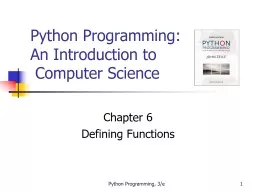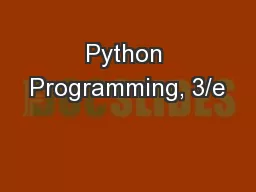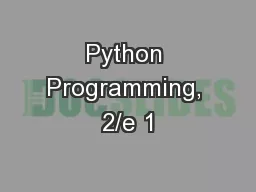PPT-Python Programming, 3/e 1
Author : mitsue-stanley | Published Date : 2019-01-20
Python Programming An Introduction to Computer Science Chapter 6 Defining Functions Python Programming 3e 2 Objectives To understand why programmers divide programs
Presentation Embed Code
Download Presentation
Download Presentation The PPT/PDF document "Python Programming, 3/e 1" is the property of its rightful owner. Permission is granted to download and print the materials on this website for personal, non-commercial use only, and to display it on your personal computer provided you do not modify the materials and that you retain all copyright notices contained in the materials. By downloading content from our website, you accept the terms of this agreement.
Python Programming, 3/e 1: Transcript
Download Rules Of Document
"Python Programming, 3/e 1"The content belongs to its owner. You may download and print it for personal use, without modification, and keep all copyright notices. By downloading, you agree to these terms.
Related Documents






![[READING BOOK]-Illustrated Guide to Python 3 A Complete Walkthrough of Beginning Python](https://thumbs.docslides.com/970240/reading-book-illustrated-guide-to-python-3-a-complete-walkthrough-of-beginning-python-with-unique-illustrations-showing-how-python-really-works-now-covering-python-3-6-treading-on-python.jpg)
![[FREE]-PYTHON PROGRAMMING FOR BEGINNERS Your Personal Guide for Getting into Programming,](https://thumbs.docslides.com/970688/free-python-programming-for-beginners-your-personal-guide-for-getting-into-programming-level-up-your-coding-skills-from-scratch-and-use-python-like-a-mother-language-python-programming-language.jpg)
![[DOWLOAD]-Python Programming for Beginners: An Introduction to the Python Computer Language](https://thumbs.docslides.com/975251/dowload-python-programming-for-beginners-an-introduction-to-the-python-computer-language-and-computer-programming-python-python-3-python-tutorial-640937bd864aa.jpg)
![[PDF]-Programming 31: Python Programming In A Day & Excel Shortcuts (Python Programming,](https://thumbs.docslides.com/979804/pdf-programming-31-python-programming-in-a-day-excel-shortcuts-python-programming-python-language-python-for-beginners-excel-programming-languages-excel-programming.jpg)
![[eBOOK]-Programming 19:C Programming Professional Made Easy & Excel Shortcuts (Excel Programming,](https://thumbs.docslides.com/980131/ebook-programming-19-c-programming-professional-made-easy-excel-shortcuts-excel-programming-microsoft-excel-python-for-beginners-c-programming-c-programming-languages-android-c-programming.jpg)
![[PDF]-Programming 3: Python Programming Professional Made Easy & C Programming Success](https://thumbs.docslides.com/980147/pdf-programming-3-python-programming-professional-made-easy-c-programming-success-in-a-day-c-programming-c-programming-c-programming-language-html-python-programming-python-java-php.jpg)
![[FREE]-Programming 16: Python Programming In A Day & C Programming Professional Made Easy](https://thumbs.docslides.com/980148/free-programming-16-python-programming-in-a-day-c-programming-professional-made-easy-c-programming-c-programming-c-programming-language-html-python-python-programming-coding-css-java-php.jpg)
![[READ]-Programming 5:C Programming Success in a Day Excel Shortcuts (C Programming, C++programming,](https://thumbs.docslides.com/988966/read-programming-5-c-programming-success-in-a-day-excel-shortcuts-c-programming-c-programming-c-programming-language-excel-javascript-programming-microsoft-excel-python-java-php.jpg)